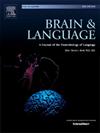双语:我们现在知道的并不都是旧闻
IF 2.3
2区 心理学
Q1 AUDIOLOGY & SPEECH-LANGUAGE PATHOLOGY
引用次数: 0
摘要
二十世纪后期个人电脑的出现引入了新的研究方法,将实验双语变成了一个强大的领域。当时,语言研究依赖于模块化的,主要是单语言的自下而上的方法,如语言用户框架。Harris的《双语者的认知过程》(1992)标志着一个转折点,激发了对双语表征、共同激活和跨语言互动等核心问题的探究。在这里,我们讨论了自本书出版以来,双语实验研究在数量和质量上是如何发展的。一些书籍主题已经成为自己成熟的研究焦点(如跨语言加工效应、双语认知控制、双语加工的计算建模),而另一些则转移了方向(如从大脑侧边性转向更广泛的双语大脑)。通过强调语言隶属度和标记性研究的进展,并在最近的大型语言模型中解决计算模型的价值,我们展示了认知双语研究在今天仍然具有高度相关性。本文章由计算机程序翻译,如有差异,请以英文原文为准。
Bilingualism: Not all we know now is old news
The advent of personal computers in the late twentieth century introduced new research methodologies, transforming experimental bilingualism into a robust field. At the time, language research relied on modular, largely monolingual bottom-up approaches like the Language User Framework. Harris’s Cognitive Processes in Bilinguals (1992) marked a turning point, stimulating inquiries into core issues concerning bilingual representation, co-activation, and cross-linguistic interaction. Here, we discuss how the experimental study of bilingualism has both quantitatively and qualitatively evolved since this book’s publication. Some book topics have become mature research foci of their own (e.g., cross-language processing effects, bilingual cognitive control, computational modeling of bilingual processing), while others have shifted direction (e.g., from cerebral laterality to the bilingual brain more broadly). By highlighting advances in research on language membership and markedness, and addressing the value of computational models over recent large language models, we show how cognitive bilingualism research remains highly relevant today.
求助全文
通过发布文献求助,成功后即可免费获取论文全文。
去求助
来源期刊

Brain and Language
医学-神经科学
CiteScore
4.50
自引率
8.00%
发文量
82
审稿时长
20.5 weeks
期刊介绍:
An interdisciplinary journal, Brain and Language publishes articles that elucidate the complex relationships among language, brain, and behavior. The journal covers the large variety of modern techniques in cognitive neuroscience, including functional and structural brain imaging, electrophysiology, cellular and molecular neurobiology, genetics, lesion-based approaches, and computational modeling. All articles must relate to human language and be relevant to the understanding of its neurobiological and neurocognitive bases. Published articles in the journal are expected to have significant theoretical novelty and/or practical implications, and use perspectives and methods from psychology, linguistics, and neuroscience along with brain data and brain measures.
 求助内容:
求助内容: 应助结果提醒方式:
应助结果提醒方式:


